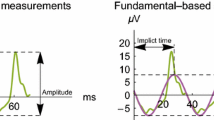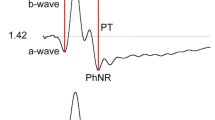Abstract
Purpose
To assess the efficacy of high luminance in increasing the amplitude of the multifocal electroretinogram (mfERG). We examined 5 male and 5 female volunteers in the age of 22–52 years (median 28 years). Three different stimulus luminance levels were applied: the bright areas of the stimulus pattern were set to 150, 300 and 500 cd/m2. We recorded the potentials via DTL electrodes using the VERIS Science 4.4 system with 61 hexagons, pupils were dilated. Analysis was based on the 5 ring averages.
Results
Across all hexagons and subjects, the response density (∼amplitude) rose by 20% when increasing the luminance by a factor of 3.3. The peak times decreased slightly with higher luminance, by less then 1.5 ms.
Conclusions
Combining the present results with those from two previous studies, the gain (= relative amplitude increase for relative luminance increase) is close to 0.4 over a range of 56–700 cd/m2. The stimulus luminance range suggested in the mfERG guidelines seems well chosen.




Similar content being viewed by others
Abbreviations
- mfERG:
-
Multifocal ERG
- CRT:
-
Cathode ray tube
References
Bach M (1998) Preparation and Montage of DTL-Electrodes. Retrieved 28.07.2006, from <http://www.michaelbach.de/dtl.html>
Dawson WW, Trick GL, Litzkow CA (1979) Improved electrode for electroretinography. Invest Ophthalmol Vis Sci 18:988–991
Gerth C, Garcia SM, Ma L, Keltner JL, Werner JS (2002) Multifocal electroretinogram: age-related changes for different luminance levels. Graefes Arch Clin Exp Ophthalmol 240:202–208
Hood DC, Frishman LJ, Saszik S, Viswanathan S (2002) Retinal origins of the primate multifocal ERG: implications for the human response. Invest Ophthalmol Vis Sci 43:1673–1685
Hood DC, Odel JG, Chen CS, Winn BJ (2003) The multifocal electroretinogram. J Neuroophthalmol 23:225–235
Marmor MF, Hood DC, Keating D, Kondo M, Seeliger MW, Miyake Y (2003) Guidelines for basic multifocal electroretinography (mfERG). Doc Ophthalmol 106:105–115
Raz D, Seeliger MW, Geva AB, Percicot CL, Lambrou GN, Ofri R (2002) The effect of contrast and luminance on mfERG responses in a monkey model of glaucoma. Invest Ophthalmol Vis Sci 43:2027–2035
R Development Core Team (2006) R: A language and environment for statistical computing. Retrieved 31.07.2006, from <http://www.R-project.org>
Sutter EE, Tran D (1992) The field topography of ERG components in man—I. The photopic luminance response. Vis Res 32:433–446
Ueno S, Kondo M, Niwa Y, Terasaki H, Miyake Y (2004) Luminance dependence of neural components that underlies the primate photopic electroretinogram. Invest Ophthalmol Vis Sci 45:1033–1040
Yoshii M, Yanashima K, Wakaguri T, Sakemi F, Kikuchi Y, Suzuki S, Okisaka S (2000) A basic investigation of multifocal electroretinogram: reproducibility and effect of luminance. Jpn J Ophthalmol 44:122–127
Acknowledgements
We thank our subjects for their ready cooperation and two anonymous reviewers for thorough critique and valuable suggestions.
Author information
Authors and Affiliations
Corresponding author
Rights and permissions
About this article
Cite this article
Schimitzek, T., Bach, M. The influence of luminance on the multifocal ERG. Doc Ophthalmol 113, 187–192 (2006). https://doi.org/10.1007/s10633-006-9028-7
Received:
Published:
Issue Date:
DOI: https://doi.org/10.1007/s10633-006-9028-7




